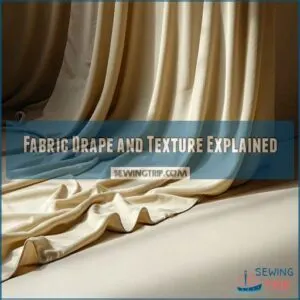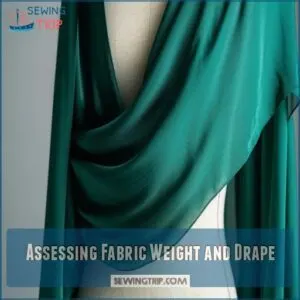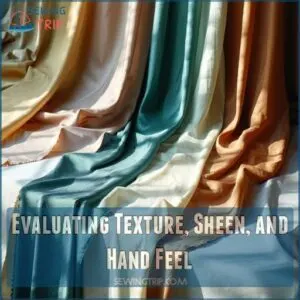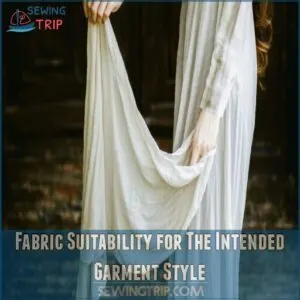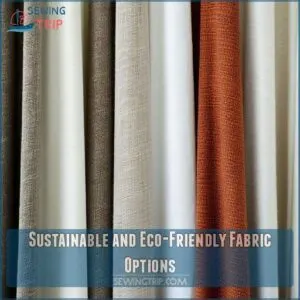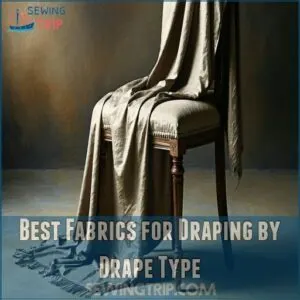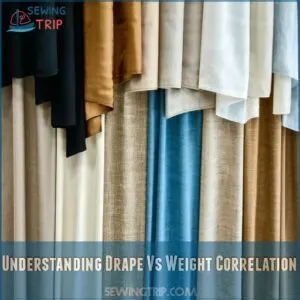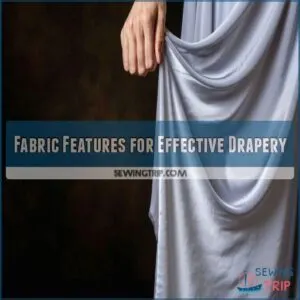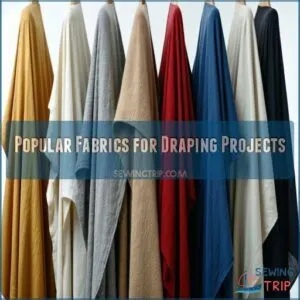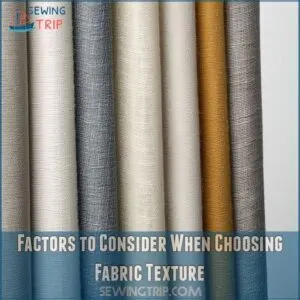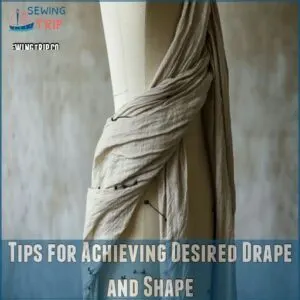This site is supported by our readers. We may earn a commission, at no cost to you, if you purchase through links.
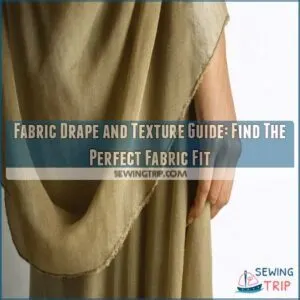 Decoding a fabric drape and texture guide can feel like a secret recipe for the perfect garment.
Decoding a fabric drape and texture guide can feel like a secret recipe for the perfect garment.
Understanding drape is key—it’s all about how fabric flows or holds its shape.
Picture silk gliding smoothly like a gentle stream or denim standing firm like a fearless soldier.
Texture adds depth, influencing the garment’s "hand" or how it feels.
Light fabrics like silk drape delicately, while heavier ones like denim offer structure.
Remember, choosing the right fabric involves juggling weight, texture, and purpose—like finding a balance between style and comfort.
And just like that, you’re on your way to fabric mastery!
Table Of Contents
- Key Takeaways
- Fabric Drape and Texture Explained
- What is Fabric Drape and How to Measure It
- Choosing The Right Fabric for Draping
- Best Fabrics for Draping by Drape Type
- Understanding Drape Vs Weight Correlation
- Fabric Features for Effective Drapery
- Popular Fabrics for Draping Projects
- Factors to Consider When Choosing Fabric Texture
- Common Mistakes to Avoid When Choosing Fabric
- Tips for Achieving Desired Drape and Shape
- Frequently Asked Questions (FAQs)
- Conclusion
Key Takeaways
- You’ll understand how fabric weight directly impacts drape; lightweight fabrics flow, while heavier ones hold their shape.
- You’ll learn to identify different drape types (low, moderate, high) and choose fabrics accordingly for various garment styles.
- You’ll consider factors beyond drape, such as texture, sheen, budget, and sustainability, when selecting fabrics.
- You’ll avoid common mistakes like ignoring fabric weight, drape, and durability, leading to better project outcomes.
Fabric Drape and Texture Explained
Understanding fabric drape and texture is like learning the secret language of materials, helping you choose fabrics that hang just right and complement your style.
With a friendly nudge, imagine fabrics as characters in a play—some dramatic and flowy, while others stand firm and strong.
How Fabric Weight Affects Drape
Ever wondered why some fabrics drape like a dream, while others stand stiff as a board? It’s all about the weight!
Lightweight fabrics, like silk, flow beautifully, creating a soft, elegant drape.
Heavier fabrics, such as denim, tend to hold their shape, offering a structured look.
But there are exceptions; a heavy fabric can still drape well, depending on its weave and fiber.
Understanding this drape correlation is key! Drape analysis involves looking at how fabric weight impacts its flow and overall texture.
Types of Fabric Drape
When you’re picking out fabric, think about the drape styles and don’t forget to reference a fabric drape chart online fabric guide for more precise results.
- Low Drape: Like denim and canvas, these fabrics add volume, making garments look fuller.
- Moderate Drape: Versatile fabrics like cotton knit and linen, great for everyday wear.
- High Drape: Silk and rayon flow beautifully, hugging the body’s lines.
Understanding these styles helps fine-tune your creations!
Factors to Consider When Choosing Fabric
Choosing fabric’s like picking a dance partner—it all boils down to compatibility.
First, consider your project’s type and desired look.
Factor in fabric drape, texture, and weight for the perfect fit, understanding that fabric selection is vital.
Don’t forget seasonality! A heavy wool for summer? No thanks.
Keep budget and fabric care in mind, ensuring your choice balances quality with practicality.
What is Fabric Drape and How to Measure It
Ever wonder why some fabrics seem to hug you just right while others give you a mind of their own?
Drape will help you measure its flow and figure out which materials are best for your next masterpiece.
Assessing Fabric Weight and Drape
Holding a fabric up might feel like a fashion magic trick, but it’s key to evaluating fabric weight and understanding fabric drape, which is essential for creating stunning silhouettes and defining garment shape.
Noticing these quirks helps you predict textile drape.
Practice makes perfect, so play with different fabrics to understand their unique characteristics, ensuring every piece is just right.
Evaluating Texture, Sheen, and Hand Feel
Picture yourself running your hand over a fabric.
It’s those tiny surface details that tell the tale of texture and style.
The sheen and drape go hand in hand, like partners in a dance, revealing elegance or modesty.
And don’t skip the hand feel test—it’s your trusty guide in the texture journey, ensuring your fabric feels just right!
Choosing The Right Fabric for Draping
Choosing the right fabric for draping is like picking the perfect dance partner—it’s all about the flow and fit.
You’ll want a fabric that suits your garment’s style and budget
but also makes you feel like a star on the eco-friendly runway.
Fabric Suitability for The Intended Garment Style
So, you’ve mastered measuring fabric drape and weight? Great! Now, let’s talk garment silhouette.
Think about the look you want: a flowing maxi dress needs high drape fabrics like silk, while a structured blazer demands something with low drape, like a sturdy cotton twill.
The fabric’s flow directly impacts the final garment’s shape. Get it right, and your project will look amazing!
Budget and Desired Aesthetic Considerations
Everyone’s got a budget, right? Choosing the right fabric involves balancing cost with your vision. Here’s how:
- Fabric Mixing: Blend high-end textiles in standout areas with more affordable pieces.
- Seasonal Sales: Keep an eye on discounts for luxury fabrics.
- Quality Over Quantity: Invest in durable materials.
- Budget-Friendly Choices: Select versatile fabrics offering both drape and texture.
Sustainable and Eco-Friendly Fabric Options
When choosing sustainable fabrics, think of draping with style and a clear conscience. Recycled fabrics and Organic cotton offer eco-friendly options, while Bamboo rayon and Tencel provide soft, flowing textures. Also, don’t forget Hemp, known for its sturdy, sustainable qualities.
| Material | Benefit |
|---|---|
| Recycled Fabrics | Eco-friendly |
| Bamboo Rayon | Soft and drapable |
| Hemp | Durable and green |
Selecting these fabrics guarantees a beautiful drape without harming the planet.
Best Fabrics for Draping by Drape Type
Ready to find the perfect fabric for your project?
Whether you’re going for elegant, voluminous, or versatile drapes, knowing the right fabric to choose can make all the difference, even if it seems like fabrics have a secret chat about how to trick us!
Fluid Drape Fabrics for Elegant Looks
Elegance shines when choosing fluid drape fabrics for your outfit wizardry.
Think about the graceful flow of silk charmeuse in evening gowns or how lightweight, soft-flowing fabrics like rayon add magic to flowy skirts.
To master fluid drape fabrics, consider learning fashion draping techniques that will bring your fabric drape to life.
Use draping techniques to bring fabric drape to life.
With this drape guide, unravel the secret to making your creations dance with every step.
Voluminous Drape Fabrics for Statement Pieces
Fabric with voluminous drape makes heads turn.
Picture bold textures and striking silhouettes in statement fabrics like velvet or brocade.
They command attention—great for making that dramatic entrance.
Mastering drape techniques can elevate project ideas, letting the fabric speak volumes.
Pay attention to texture impact.
And a little humor, watch out for those tricky maintenance needs!
Moderate Drape Fabrics for Versatility
Moderate drape fabrics, like cotton and wool blends, strike a balance between structure and flow.
Here’s how you can make the most of them:
- Perfect for daily wear: They offer comfort without clinging.
- Versatile for various projects: Use in dresses, pants, or jackets.
- Care tips: Easy machine washing.
- Affordable alternatives: Quilting cotton or linen offer similar utility.
Understanding Drape Vs Weight Correlation
You might think heavier fabrics always drape poorly, but that’s not always true!
We’ll explore how fabric weight and drape are linked, but also where they surprisingly differ—it’s more fun than it sounds, promise.
Exceptions to The Rule
Imagine you’re choosing fabrics and discover the quirky exceptions to the rule. Even lightweight cotton can be as stiff as a board, while heavyweight draping fabrics like wool can flow beautifully.
It’s all about understanding drape variations and types.
Here’s a quick breakdown:
| Fabric | Weight | Drape |
|---|---|---|
| Lightweight Cotton | Light | Stiff |
| Heavy Wool | Heavy | Fluid |
| Silk Blend | Medium | Flowing |
| Polyester | Medium | Stiff |
Importance of Considering Both Weight and Drape
Ever thought fabric choice was a no-brainer? Think again! Understanding fabric weight and drape is important for any textile project.
It’s like finding that perfect balance between a cozy sweater and a flowing dress.
Here’s how to nail it:
- Texture counts.
- Weight influences shape.
- Drape affects flow.
- Different fabrics, different impacts.
- Think fabric longevity.
Fabric Features for Effective Drapery
When you’re picking fabric for drapery, think of it like choosing a partner for a dance—durability, light control, and insulation are key steps.
Whether your fabric needs to block summer’s heat or filter the morning sun gently, knowing these features will make your curtains both beautiful and practical.
Durability and Longevity Considerations
When you’re picking fabrics, durability and longevity should be on your radar.
Think about how a fabric’s care routine can affect its lifespan.
Here’s a quick guide:
| Feature | Considerations |
|---|---|
| Fabric Care | Easy wash or hand wash requirement? |
| Stain Resistance | Can it resist pesky spills? |
| Wrinkle Recovery | Does it bounce back or crumple easily? |
| Fabric Lifespan | How many wears before it shows wear? |
| Texture & Weight | Does it match your drape expectations? |
Light Control and Light Filtration Options
You want the sunlight to dance softly through your space, right?
Embrace fabrics that offer light control and transparency for perfect daylighting.
Opt for those that diffuse light to maintain privacy without sacrificing room ambiance.
Look for lightweight drapes that flow elegantly, ensuring the texture complements your aesthetic while managing fabric weight and drape for that seamless, airy vibe.
Insulation Against Heat and Cold
Insulation in fabric isn’t just about staying warm in winter—it’s about keeping cool in summer too.
Think of heavyweight silks or wool for thermal regulation.
These fabrics manage heat transfer well, offering winter warmth and summer breathability.
For an easy and effective solution, consider installing thermal curtains online.
Whether draping curtains or crafting jackets, choosing the right texture and drape guarantees comfort across seasons, adding that perfect balance to your projects.
Popular Fabrics for Draping Projects
Ready to explore the best fabrics for your next draping masterpiece?
We’ll cover popular choices like cotton, linen, rayon, and blends,
so you can find the perfect fit for your project—no more fabric-related frustrations!
Natural Fabrics Like Cotton and Linen
Cotton and linen dominate as go-to natural fabrics for their effortless drape and delightful texture.
Picture linen’s breezy wrinkles adding character or cotton’s robust threads offering versatile charm.
They’re not just comfy but also eco-friendly with sustainable sourcing.
Cotton care’s a breeze, while linen’s natural dyes flaunt unique hues, making them perfect fabric blends for any project.
Synthetic Fabrics Like Polyester and Rayon
Synthetic fabrics like polyester and rayon offer unique advantages for draping projects.
Polyester shines with durability and easy care, but might feel a tad plasticky.
Rayon, softer and silkier, flatters with a graceful drape but requires gentle handling.
When weighing polyester vs. rayon, consider texture variations and sustainability concerns.
Each offers distinct vibes—choose wisely for your creative journey!
Blended Fabrics for Unique Properties
Ever wonder how blended fabrics can be the superhero of your sewing projects?
They combine the best of different fibers for enhanced performance, unique texture variations, and cost-effectiveness.
You get customizable drape properties, so you can tailor-fit your creations perfectly.
Imagine the possibilities—smooth as silk, tough as denim, and just the right amount of stretch—all in one fabric!
Factors to Consider When Choosing Fabric Texture
When you’re picking fabric texture, think about how it will impact the overall feel and flow of your project—it’s like choosing between velvet and sandpaper!
Don’t forget that even the smallest textures can play a big role in how your creation looks and feels, adding that essential touch of personality.
Color and Pattern Selection
Picking the perfect color and pattern is like choosing the right spice for your meal; it sets the tone and can make or break your outfit.
To make sure your color choices work well together, consider using a color wheel to create contrast and balance, such as selecting complementary colors for bold contrast.
Consider how color impact and pattern scale play with your fabric drape.
Use contrast for a pop, but make sure the colors harmonize.
Patterns should complement the textile texture, not clash.
Texture and Weight Considerations
Choosing fabrics isn’t just about colors and patterns; texture and weight are your real game-changers.
They shape how fabric flows—do you want to drape like water or stand its ground?
Consider the fabric weight recommendations on your pattern envelopes, as they influence drape and fit.
Feel that fabric.
Heavy, soft, scratchy—each has a unique role in your project.
It’s your fabric’s story, blending touch with style.
Happy fabric hunting!
Opacity and Light Control Options
Let’s explore opacity and light control! Think of it like this: do you want the sun to shine through, or do you need more privacy?
- Sheerness: For a breezy, translucent look.
- Light filtering: Softens sunlight without total darkness.
- Privacy fabrics: Offer more coverage.
- Opacity: How much light gets through.
- Light control: Manage light and privacy. These fabric characteristics are key!
Common Mistakes to Avoid When Choosing Fabric
Choosing fabric isn’t just about grabbing the prettiest bolt off the shelf; it’s easy to overlook factors like weight, drape, and even how it feels in your hands.
Don’t find yourself regretting a project because you ignored texture or forgot to check if it could handle the washing machine—savvy choices today save countless head smacks tomorrow!
Ignoring Fabric Weight and Drape
Fabric choice mistakes can turn your dream project into a sewing challenge nightmare.
Ignoring fabric drape and weight is like baking without measuring—things won’t rise or fall as planned.
Garment fit issues often stem from this oversight, leading to project failure.
Keep fabric drape in mind to predict how your piece will flow and fit perfectly.
Overlooking Texture and Sheen
Don’t forget your fabric’s feel!
Ignoring texture and sheen can lead to bland outfits.
Imagine aiming for elegance but ending up with dullness—ouch!
Texture adds depth and sheen influences how light plays on the surface, creating a drape illusion that boosts visual appeal.
Pay attention to fabric hand feel for a more dynamic, engaging look!
Failing to Consider Durability and Maintenance Needs
Ignoring texture and sheen is like missing the sparkle in your wardrobe.
Equally important, failing to think about durability and maintenance can turn that fashion dream into a chore.
Watch out for:
- Fabric longevity: Will it hold up or fade fast?
- Wrinkle resistance: Nobody wants extra ironing.
- Stain resistance: Fend off those surprise spills.
- Cleaning challenges: Know your care instructions!
Tips for Achieving Desired Drape and Shape
Achieving that perfect drape and shape in your fabric projects can feel like trying to teach a cat to fetch, but it’s much easier with a few clever tricks!
By positioning and pinning fabric on a dress form and experimenting with its movement, you’ll discover the secret to creating garments that flow beautifully and fit comfortably.
Positioning and Pinning Fabric on a Dress Form
Mastering dress form pinning techniques starts with careful fabric manipulation to achieve the perfect drape.
Use your pinning tools wisely, placing each pin strategically for the best drape control.
Think of pinning placement like mapping a treasure trail; every pin sets a course for stunning results.
Stay patient, embrace trial and error, and your draping techniques will shine.
Experimenting With Fabric Movement and Flow
Now that your fabric’s pinned perfectly, let’s play with it!
Experiment! Gently tug and drape to see how the fabric moves.
Notice how different manipulations affect the flow.
See how subtle shifts in fabric placement create big changes in the visual impact and overall silhouette.
It’s like sculpting with cloth!
You’ll quickly get a feel for fabric manipulation and its effects on drape and flow variations.
Have fun exploring!
Achieving Desired Drape and Shape Techniques
When you’re diving into fabric manipulation, think of it as sculpting with fabric.
Draping techniques can help you get that perfect fabric drape.
To get the right fabric for your project, you can find a wide range of drape fabrics at Drape fabric online stores.
Shape control comes from a good balance of draping effects and pattern cutting.
Picture shaping flowing garments like a friendly dance—each move counts in garment construction for that polished texture and refined look.
Frequently Asked Questions (FAQs)
What fabric textures go together?
Pair smooth fabrics like silk with textured ones like tweed to create contrast and interest.
Mixing matte and shiny materials adds dimension, making your outfit pop.
Trust your instincts and have fun experimenting with combinations!
How do you describe the drape of a fabric?
Ever wonder how fabric dances?
Drape reveals this!
It shows how fabric hangs, whether it flows like a waterfall or stands firm like a statue.
Soft, flowing examples captivate; stiff ones offer structure and presence.
What is the best fabric for draping?
Silk is your best bet for draping, thanks to its luxurious flow and vibrant sheen.
It hugs curves and creates elegant silhouettes, making it perfect for dresses and scarves.
Plus, it feels like wearing a gentle breeze!
How do you describe the texture of fabric?
Imagine feeling fabric: is it rough like a badger’s back, or smooth as a baby’s cheek?
Note its softness, its smoothness, or its roughness.
Consider its weight and how it hangs.
How do humidity and temperature affect fabric drape?
Humidity and temperature can shift fabric drape, much like a mood swing.
High humidity makes fabrics feel heavier and clingy, while cooler temperatures can stiffen fibers, affecting their flow and changing how garments hang on you.
Can printing techniques impact fabric drape?
Printing techniques can influence fabric drape by adding weight or stiffness.
Techniques like screen printing may alter texture, affecting how fabric falls or hugs the body.
Consider this when choosing fabrics for specific garment styles.
How does fabric dye affect drape quality?
Fabric dye can alter drape quality by changing fiber stiffness and weight.
Certain dyes may stiffen fibers, reducing drape, while others soften, enhancing flow.
Always check dye compatibility with fabric for desired drape outcomes.
What role does fabric blend play in drape?
Ever wondered why some fabrics drape like a dream while others don’t?
Blends are key here.
Mixing fibers like cotton and polyester balances structure and fluidity, influencing the fabric’s drape.
It’s all about synergy, baby!
How does washing affect fabric drape and texture?
Washing can alter fabric drape and texture by softening or tightening fibers, leading to changes in how the fabric hangs.
Shrinkage or stretching may occur, affecting fit and feel.
Test with a small piece first!
Conclusion
Picture yourself as a maestro, orchestrating the perfect ensemble with each fabric as a unique instrument.
Mastering the fabric drape and texture guide is like finding harmony in sartorial symphonies.
You’ll navigate the elegant flow of silk or the robust structure of denim with ease.
Balance texture with aesthetic, sustainability, and purpose.
Begin your creative process confidently, knowing how weight, texture, and drape work together to create both style and comfort.
Now, let your fabric journey begin!

